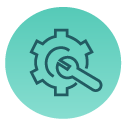What this guide contains
Deploying Microsoft 365 Copilot at Microsoft
Welcome to the new era of productivity

Generative AI has captured the world’s attention, and businesses are taking notice. According to our Work Trends Annual Report, 70% of people would delegate as much work as possible to AI to lessen their workloads.
Capitalizing on this trend will mean the difference between surging ahead or getting left behind, including here at Microsoft, where we’re the first enterprise to fully deploy Microsoft 365 Copilot.

“I’m inspired by the transformative power of AI,” says Nathalie D’Hers, corporate vice president of Microsoft Digital, the company’s IT organization. “I’ve been impressed with how quickly our employees have put it to work for them.”
She would know—her team just finished deploying Microsoft 365 Copilot to more than 300,000 employees and vendors across the world.
“Customers are looking to us to share what we’ve learned as the first enterprise to deploy Copilot,” D’Hers says. “Our team has a unique opportunity to help them deploy and get to value as quickly as possible.”
Meet Microsoft 365 Copilot
Microsoft 365 Copilot combines the power of large language models (LLMs) with your organization’s data to turn your employees’ words into some of the most powerful productivity tools on the planet—all within the flow of work. It works alongside the Microsoft 365 apps people use every day, including Word, Excel, PowerPoint, Outlook, Teams, and more, to provide real-time intelligent assistance.
According to our Work Trends annual report, our employees and external customers who got early access found Copilot very useful:
70%
of users said they were more productive at work.
64%
reported they spent less time processing email.
85%
shared that Copilot helps them get to a good first draft faster.
75%
highlighted time savings through improved document discovery.
Organizations like ours that are unlocking AI assistance within employees’ everyday workflow are poised to gain a distinct advantage in terms of productivity, engagement, and innovation.
“We’re using it to reduce our IT expenses and to enhance our productivity,” D’Hers says. “We’re also excited by its potential to create a lasting competitive advantage for us here at Microsoft and for our customers.”
Our mission in Microsoft Digital is to empower, enable, and transform the company’s digital employee experience across devices, applications, and infrastructure. We also provide a blueprint for our customers to follow, and as such, have created this guide for deploying and adopting Microsoft 365 Copilot.
“The contents of this guide are based on the lessons we’ve learned deploying Microsoft 365 Copilot,” D’Hers says. “The tips and ideas you’ll read here will help you accelerate your own time to value with Copilot so you can realize the same benefits as our employees.”
Follow along
Learn from our experience and capture the benefits that Copilot has to offer your employees and your organization.
Chapter 1: Getting governance right
Maintaining privacy, security, and compliance while respecting regulatory frameworks
Before you begin your Microsoft 365 Copilot implementation, you’ll want to consider how this tool impacts your data. Copilot uses LLMs that interact with data and content across your organization and uses information your employees can access to transform user prompts into personalized, relevant, and actionable responses throughout Microsoft 365 apps.
Giving your employees this level of access means proper data hygiene is a priority. At Microsoft Digital, we use sensitivity labeling to empower our employees with access while also protecting our data. Our colleagues on the product side designed Microsoft 365 Copilot to respect labels, permissions, and rights management service (RMS) protections that block content extraction on relevant file labels. By implementing effective sensitivity labeling practices, you can rest assured that anything you intend to remain private or confidential will stay that way.
Pick the governance path that’s right for you
This chapter outlines the highly robust, best-case scenario we created at Microsoft, but we know not every organization has a fully deployed data governance system and strategy. If you’re in that position, don’t worry! You can use techniques like Restricted SharePoint Search that provide value and protection without exposing Copilot to your internal resources.
Laying the groundwork with proper labeling
Throughout our internal governance efforts within Microsoft Digital, we’ve developed four labeling practices that make up our foundation for appropriate policies and settings.

Responsible self-service
Support and enable your employees to create new workspaces like SharePoint sites, ensuring your company data is on your Microsoft 365 tenant and employees don’t simply reuse and overload existing spaces with mismatching permissions. That enables your employees to take full advantage of Copilot in ways that align with your organizational data hygiene while you keep your company’s information safe.

Top-down defaults
Label containers for data segmentation by default to ensure your information isn’t overexposed. At Microsoft, we default our container labels to “Confidential\Internal Only.” That ensures alignment with our policies and settings that limit external sharing. We use Microsoft Purview to manage this process.

Consistency within containers
Derive file labels from their parent containers. Being consistent here boosts security across every layer and reduces the administrative burden on your employees to label every file they create. Copilot will reflect file labels in chat responses, so employees know the level of confidentiality of each portion of AI-created responses.

Employee awareness
We train our employees to understand how to handle and label sensitive data. By making your workers active participants in your data hygiene strategy, you increase accuracy and your overall security posture.
Self-service with guardrails
The data hygiene practices we outlined above form a foundation for compliance and security, but backstopping those efforts through Microsoft 365 features adds an extra layer of protection. That’s a core principle of Zero Trust.

Trust, but verify
Empower self-service with sensitivity labels, but verify them by checking against data loss prevention standards, then use auto-labeling and quarantining when necessary. Internally, we’ve configured Microsoft Purview Data Loss Prevention to detect and control sensitive content automatically.

Expiry and attestation
Put strong lifecycle management protocols in place that require your employees to attest containers to keep them from expiring. We don’t keep items that don’t have an accountable employee, or that might not be necessary for our work.

Controlling the flow
Limit oversharing at the source by enabling company-shareable links instead of forcing employees to grant access to large groups. At Microsoft, we add an extra layer of highly confidential items users can only share with specific people on a need-to-know basis. To enforce these behaviors, you can set default link types based on labels through Purview.

Oversharing detection
Even under the best circumstances, accidents happen. When one of our employees does overshare sensitive data, we use Microsoft Graph Data Connect extraction in conjunction with Microsoft Purview to catch and report oversharing.
International compliance: No size fits all
Europe has extra requirements in the form of EU Data Boundary regulations and works councils—internal organizations that provide employee co-determination on workers’ rights or regulatory issues, including performance management or monitoring. Our Microsoft 365 Copilot deployment meant we needed to partner closely with our Microsoft works councils when launching an AI technology with complex data and privacy implications.
Your experience will vary depending on your industry and where you operate, but we’ve learned that it’s best to work closely with local subsidiaries to ensure you have a complete picture of a region’s regulatory situation. Local insiders are poised to liaise with their works councils (here’s how we do so internally at Microsoft) or other bodies through direct relationships. Start the process early so you can manage feedback cycles effectively, make adjustments, synthesize any answers works councils need, and resolve any concerns through configurations that work for your employees.
Learning from Microsoft’s governance, security, and compliance practices

Bring the right people into the conversation
Don’t keep this conversation in the IT sphere alone. Bring in all the relevant security, legal, and compliance professionals.

Build a foundation for automation
Microsoft Purview Data Loss Prevention has powerful intelligent detection, but it relies on establishing good defaults.

Think about how your employees will use Copilot
Determine the primary use cases for Copilot. The kinds of collaboration and access employees need will affect your default labeling architecture.

Take this opportunity to train employees
If you’ve been looking for an excuse to refresh employee knowledge around data privacy, let this moment be your milestone. It will be far easier to start with a clean data estate.

Don’t overwhelm your employees
Make labeling simple and intuitive, and ensure it isn’t overwhelming. Employees should have a limited set of choices to keep things comprehensible. It’s also valid for different employees to see different choices.

Balance good governance with time to value
Because of the scope and complexity of Microsoft’s deployment, we took a very thorough approach to governance. If speed is your priority, you might consider a faster deployment with a less comprehensive governance approach, for example, using Restricted SharePoint Search to restrict both Enterprise Search and Copilot experiences to a curated set of SharePoint sites of your choice.
Deployment checklist: Governance
We put this checklist together based on what we learned while tackling governance, security, and compliance.

Labeling
- ❏ Develop a labeling taxonomy. Include:
- ❏ Classification levels, not exceeding five primary labels and five sub-labels
- ❏ Descriptions clearly outlining the label meaning for employees
- ❏ Examples to clarify usage for employees
- ❏ Determine policies and settings that correspond with labels. Consider the following:
- ❏ Storage type and location
- ❏ External allowance
- ❏ Encryption
- ❏ Access control
- ❏ Data destruction
- ❏ Data loss prevention
- ❏ Public disclosure
- ❏ Logging and tracking access
- ❏ Establish container defaults.
- ❏ Configure container labels to set the default file label in document libraries.
- ❏ Initiate an employee education initiative.

Data loss prevention
- ❏ Configure Microsoft Purview Data Loss prevention standards and quarantining protocols.
- ❏ Establish lifecycle management and attestation protocols.
- ❏ Configure Microsoft Graph Data Connect to discover where you are oversharing.

International compliance
- ❏ Initiate conversations with local subsidiaries.
- ❏ Engage works councils or other advocacy bodies.
- ❏ Address concerns.
- ❏ Determine the feasibility of regional deployment and segment if necessary.

How we did it at Microsoft
Use these assets to guide your own deployment and adoption—they represent how we did things here in Microsoft Digital.

Learn how we’re getting the most out of generative AI internally here at Microsoft with good governance. This story shares what our Microsoft Digital governance team learned deploying Copilot here at Microsoft.

Check out how we’re using sensitivity labels to empower our employees while making Microsoft more secure. This article shows you how having a preestablished plan for labeling helped our Microsoft Digital team quickly deploy Copilot with proper guardrails.

More guidance for you
Here are more assets that we found useful.
Support for governance teams
- Conduct the Microsoft 365 Copilot Optimization Assessment to understand your level of AI adoption and chart your course.
- Access Microsoft Learn documentation to learn about data, privacy, security, and Zero Trust principles.
- Work through this learning path to understand Copilot and how to ensure security and compliance.
- Watch this video to get ready for your Copilot deployment.
Find these resources and more at adoption.microsoft.com.
Downloadable governance assets
We’ve adapted these assets from Microsoft Digital’s deployment material so you can use them within your organization.
Find further downloadable assets to support your governance efforts in the appendix.
Follow along
Learn from our experience and capture the benefits that Copilot has to offer your employees and your organization.
Chapter 2: Implementation with intention
Building a strategy for licensing, administration, and rolling Microsoft 365 Copilot out to different groups within your organization
Implementing Microsoft 365 Copilot isn’t as easy as just turning on licenses and alerting your users. It takes organizational partnerships, early assessments of your concrete business needs, and careful planning.
Design for the “who”
Microsoft 365 Copilot is a new concept in business software. At the time of our implementation, we were the first company to roll it out anywhere in the world, and our Microsoft Digital implementation team had to choose from countless ways to approach a licensing strategy—different mechanisms of licensing, automation, management, and more. Regardless of your overall approach, we’ve learned from experience that it almost always makes sense to start with pilot groups who can validate the tool and enable the rest of your organization.
For us, that looked like this:
Phase zero
We gave our Copilot engineering team early access to Copilot so they could test it from an insider’s perspective. We shared our early feedback with the product team.
- Product engineers
Phase one
We issued a limited number of on-demand licenses in core scenarios to get validation and feedback for key use cases.
- Marketing
- Sales
Phase two
We extended licenses to teams who needed to understand and support Copilot or provide approval for use.
- Support
- HR
- Legal
- Security
- Works councils
Phase three
We deployed Copilot and started working on adoption across the entire company.
- Advancing in phases, we deployed it to more than 300,000 Microsoft employees and external staff.
Scaling out your licenses
After you decide on the general shape of your rollout, you can begin building your licensing strategy. Fortunately, if your organization uses Microsoft 365, you’ll already have access to most of the apparatus you need. The inherent flexibility of Microsoft 365 licensing means you can easily adjust your licensing strategy as you progress based on scale, organization changes, or any other factors.
At Microsoft Digital, we started with individual licenses at the single-user level. As our implementation scaled, we tied licensing automation to Microsoft 365 groups to implement targeted licensing changes at scale. Those groups could include tailor-made subsets of employees or entire organizations within Microsoft, and we keyed our automation logic to their expanding and contracting eligibility.
We highly recommend defining a phased rollout strategy and structuring your groups accordingly. That creates accountability and gives your IT admins a crucial point of contact for understanding the licensing needs of different groups within your organization.
From Microsoft Digital’s implementation experience, there are three main benefits to using groups:

Optimize licensing costs
Create groups that reflect your business needs and goals that are aligned with your respective business sponsors. Sync your licensing status changes with your group membership changes. That way, you can assign the right licenses to the right users and adjust easily if you require frequent changes (e.g., in your early initial validation phase) and avoid paying for licenses you don’t need or use.

Refine admin costs
Group-based licensing enables your admins to assign one or more product licenses to a group. This depends on your rollout strategy and progress—your admins will be able to streamline your group setup at scale, reducing your admin overhead, which is helpful considering all the licenses you likely need to manage.

Enhance compliance and security
This ensures that only authorized users are licensed and have access to resources, enhancing your security and compliance. Your admins can use audit logs and other Microsoft Entra services to monitor and manage your group-based licensing activities.
Pre-adoption communications
Given the excitement around AI tools, one of the biggest challenges during our phased implementation was support requests from employees not within our initial pilot groups. Most of our support requests at this stage were essentially asking, “Where’s my license?” It was a key learning for our Microsoft Digital implementation team.
You can easily avoid the issue through clear and honest communication. For example, when you alert your initial implementation groups about their Copilot access, you could simultaneously deploy “Coming soon” emails to the rest of your organization. That will help you avoid any confusion while simultaneously generating excitement and boosting general adoption when the time comes.
In the end, what’s most important is building a strategy around who should have access to Copilot, at what phase, and how you can effectively communicate that information. In addition to leadership sponsorship being especially important in later phases of adoption, it’s also crucial here as a way of identifying who should be part of pilots and subsequent cohorts. Leaders can help communicate those decisions.
The bottom line is that your IT implementation team can’t work in isolation. Communication—especially with organizational leadership—will be a key part of your licensing and implementation strategy.
Learning from our implementation

Design for the “who”
When you determine your initial cohorts, base your decisions on which roles have the largest coverage and will provide the most relevant feedback.

Get your groups in place
Be thoughtful about your Microsoft 365 groups and make sure everyone knows who owns them and who’s responsible.

Engage your support team from the start
This is a new technology, so your support teams will receive requests. Ensure they’re ready by giving them early access.

Manage expectations to minimize blowback
Proactively help users understand why they have licenses or don’t. Note that your rollout strategy might be subject to change.

Bring leadership on board early
Executive sponsorship isn’t just useful for adoption. Leaders will also help you identify the key use cases within their organizations to determine if they belong in early rollout phases.

Product feedback at every level
Encourage feedback for employees in your early implementation phases, because that will guide your wider adoption efforts.
Deployment checklist: Implementation
This checklist reflects Microsoft Digital’s learnings as we worked through Microsoft’s internal implementation and admin process.

Get ready
- ❏ Perform the Microsoft 365 Copilot optimization assessment.
- ❏ Identify key implementation phases and groups.
- ❏ Secure leadership involvement.
- ❏ Build out your implementation plan and map it to a licensing strategy.

Onboard and engage
- ❏ Assemble groups and assign responsibilities.
- ❏ Build an automated Microsoft 365 licensing management workflow.
- ❏ Enable reports roles for Microsoft 365 Copilot reports and the Copilot dashboard.
- ❏ Assign licenses and configure them using the setup guide.
- ❏ Analyze pilot data:
- ❏ Access in-app feedback.
- ❏ Facilitate feedback sessions.
- ❏ Analyze usage reports.
- ❏ Deploy communications: For strategy around this element, see the next section.

How we did it at Microsoft
Use these assets to guide your own deployment and adoption—they represent how we did things here in Microsoft Digital.

More guidance for you
Here are more assets that we found useful.
Support for implementation teams
- Conduct the Microsoft 365 Copilot Optimization Assessment to understand your level of AI adoption and chart your course.
- Work through this learning path to understand Copilot and how to ensure security and compliance.
- Check out this learning path to understand Copilot’s licensing and administration implications.
- Watch this video to get ready for your Copilot deployment.
- Access the Copilot scenario library to understand different user needs and licensing scenarios.
Find these resources and more at adoption.microsoft.com.
Downloadable governance assets
We’ve adapted these assets from Microsoft Digital’s deployment material so you can use them within your organization.
Find further downloadable assets to support your implementation efforts in the appendix.
Follow along
Learn from our experience and capture the benefits that Copilot has to offer your employees and your organization.
Chapter 3: Driving adoption to capture value
Effective adoption: From readiness to empowerment
The fact that your employees are excited to try out a powerful new technology platform isn’t enough. We found that you need strategic, coordinated change management efforts to drive Microsoft 365 Copilot adoption.
That way, you can be sure to get your employees onboard at the right time in the ways that you want—the idea is to give them freedom be themselves with proper guardrails.
Consider breaking your company-wide adoption into cohorts, for example, subsidiaries or business groups. We divided our adoption along two vectors: internal organizations like legal or sales and marketing, and regions like North America or Europe. Different cohorts have different focuses, but the strategy is similar.
Get ready
Identify and prioritize adoption scenarios and supporting resources.
Onboard and engage
Build and launch your adoption plan.
Deliver impact
Encourage usage and remove obstacles that could drive down satisfaction.
Extend and optimize
Measure success and find opportunities to drive usage over time.
Effective change management needs careful planning. Our adoption efforts took inspiration from the Microsoft Engagement Framework, which we’ve developed specially for driving adoption of our products. If you’re an adoption specialist or change manager, you might notice similarities with Prosci’s ADKAR model, which progresses through awareness, desire, knowledge, ability, and reinforcement.
Whichever framework you choose, the techniques we use here at Microsoft will apply. Either way, the process starts with your people.

Get ready
Begin by working with your company-wide adoption leads, then identify members of your target cohorts who will support the adoption, including change managers, leadership sponsors, and employee champions.
Champions will be crucial to your adoption by filling several powerful roles:
- Pinpointing key usage scenarios for Copilot based on their cohort’s culture or processes.
- Deciding on the best methods of communication.
- Providing insights that help adoption leaders build out their rollout plans.
- Most importantly, demonstrating the value of Copilot and showing their peers how powerful this tool can be in their day-to-day work.
When champions socialize their tips and tricks, our experience at Microsoft Digital has revealed that it’s best to share specific prompts and the value they provided as a concrete entry point for users. For example, a champion could say, “I saved three hours drafting this sales script in Microsoft Word using this prompt,” then share their Copilot prompt as a place for peers to start.
Works councils also play a key role at this stage. They offer the benefit of local cultural expertise and can help you identify challenges employees face in their jurisdictions. Even something as simple as understanding proper modes of address helps smooth the road to adoption through effective communication.
Each set of stakeholders has a role to play leading your own rollout. We recommend using Microsoft 365 Copilot adoption resources to build out your own adoption plan.

Onboard and engage
At Microsoft, we implemented this phase across each adoption cohort. Because every group will have its own champions and leadership sponsors, it’s important to treat each of them as its own organization, with its own unique adoption needs.
In advance of our general rollout, we deployed jump-start communications with links to learning opportunities:
- Localized training took the form of Power Hours in different languages and time zones. These training sessions demonstrated key Copilot scenarios across Microsoft 365 apps.
- Self-learn assets included user quick-start guides, demo videos, and Microsoft Viva Learning modules to accommodate different learning styles and preferences.
From our experience at Microsoft Digital, pre-rollout communications fulfill two needs. First, this messaging is a great opportunity to launch your champion communities because early access to Copilot licenses and learning material helps peer leaders build their expertise. Second, these communications build your general adoption population’s desire and excitement for their incoming Copilot licenses, then prepare them to hit the ground running when they finally get access. Clear messaging also helps ward off questions from eager employees asking why they don’t have licenses yet.
After your Copilot licenses are live, your launch-day welcome communications are relatively simple. Just invite employees to access Copilot, play with this new tool, and start to experiment with how it can fit into their work. It’s also helpful to include information about where employees can get support. There are many possible vectors for deploying these communications, but a multi-pronged effort that includes Microsoft Viva Amplify will deliver the maximum impact.
For support in building out your own communication plan, our adoption team has created a user onboarding kit for Copilot. These ready-to-send emails and community posts can help you onboard and engage your users.

Deliver impact
After everyone has access, it’s time to promote Copilot usage and ensure your employees are getting the best possible experience and most value. For Microsoft’s cohorts, employee champions and leadership sponsors were essential levers.
It’s important to remember that Copilot isn’t just another tool. It introduces a whole new way of working within employees’ trusted apps. At Microsoft Digital, we took great care to encourage employees to be adventurous and lean into a mindset shift to see it as part of their daily work—not just something they play with when there’s time.
Microsoft Viva Engage or a similar employee communication platform is a helpful forum for peer community support. In our case, it provided an organic space for champions to share their expertise and change managers to provide further recommendations and adoption content. For employees who explore best on their own, Copilot Lab provides in-the-flow learning opportunities to build their prompt skills.
Meanwhile, leadership sponsors diversified our communications strategy by deploying and amplifying messaging through executive channels like org-wide emails or Microsoft Viva Amplify. Because we broke our adoption out by both organization and region, employees benefited from two sets of communications, each focusing on different scenarios.

Extend and optimize
Finally, successful adoption depends on measurement, feedback, and listening.
Understanding overall usage patterns and impact is crucial to optimizing usage. Our Microsoft Digital team used a combination of controlled feature rollout (CFR) technology while tracking usage through Microsoft 365 Admin Center, the Copilot Dashboard, and Viva Insights. Together, these tools gave us the visibility and tracking we needed to establish and communicate adoption patterns. Meanwhile, IT admins and user experience success managers can access simple in-app feedback through Microsoft 365 Admin Center. But to really maximize value, our Microsoft Digital employee experience teams conducted listening sessions and satisfaction surveys.
All these insights are helping us establish a virtuous cycle to drive further value and better adoption for future rollouts, extend usage to new and high-value scenarios, incorporate Copilot into business process transformation, and understand custom line-of-business opportunities.
Driving user enablement with Microsoft Viva
Microsoft Digital used Microsoft Viva to help enable our 300,000+ global users. Microsoft Viva is an Employee Experience Platform that brings together communication and feedback, analytics, goals, and learning in one unified solution. Microsoft Digital used Viva across a range of change management scenarios, including building awareness, communicating with our employees, providing access to readiness and learning resources, and measuring the impact of our deployment.
Accelerating Microsoft 365 Copilot with Viva

Viva Connections
Sharing key news related to deployment and enablement, generating “buzz,” and tying Copilot to Microsoft culture.

Viva Amplify
Producing and efficiently distributing employee communications to build awareness and excitement.

Viva Learning
Courses and training for our employees on how to maximize value from Copilot, inclusive of building effective prompts.

Viva Goals
Establishing and tracking Objectives and Key Results (OKRs) focused on employee Copilot usage and productivity gains.

Viva Engage
Actively engaging employees, providing leader updates, listening to feedback, and enabling Champs community.

Viva Insights
Using the Microsoft 365 Copilot Dashboard beta to identity actionable insights and usage trends.

Viva Pulse
Instant feedback from employees on their Copilot experience to fine-tune our landing and adoption approach.

Viva Glint
Understanding employee sentiment and gauging the overall effectiveness of our Copilot deployment effort.
We’re using Microsoft Viva to power employee adoption of Microsoft 365 Copilot here at Microsoft.
Targeted, tailored adoption efforts
Throughout our adoption and optimization efforts, we discovered two things: certain roles find Copilot especially helpful, and those roles benefit from more tailor-made, scenario-based adoption support.
Consider these examples:
- A human resources professional might use Copilot to create job descriptions by prompting it to suggest essential skills, qualifications, and responsibilities for a prospective role.
- A salesperson could ask Copilot to generate a table comparing their company’s flagship product with a competitor’s to address customer questions more efficiently.
- A finance professional might prompt Copilot to review and summarize a new contract to reduce the time it takes to search for key data.
Any single approach would never be adequate to address every different discipline and use case. So, we built a process that Microsoft’s internal departments and our customers can use to construct their own role-based scenarios based on their individual teams’ unique needs. The result was our Microsoft 365 Copilot Hero Scenario Playbook.
We designed this playbook to help adoption professionals accomplish the following objectives:
- Understand the top responsibilities, challenges, needs, and wants of prioritized roles.
- Articulate and communicate hero scenarios by clearly depicting how Copilot can enable them.
- Share deliverables that include roles, scenarios, and prompts with the wider organization to drive awareness, adoption, engagement, and value.
Through internal testing and scenario crafting, we developed a four-part framework for creating, delivering, and socializing hero scenarios across any organization. These are the steps you can follow to create Copilot support content for adoption efforts tailored to specific roles.
Phase 1: Ready
This phase will help your organization, department, or team prepare for the process. It involves aligning with leadership and sponsors who will be accountable for driving Copilot value within their organization. It’s also where you’ll select the priority roles, draft outlines of those roles so you can clarify your understanding of their needs and wants, and seek out feedback from leaders, managers, and subject matter experts.
Phase 2: Engage
Engaging with employees is the key to uncovering Copilot’s core value. In this phase, you’ll identify participants from your priority roles who demonstrate enthusiasm and early aptitude with the tool. From there, you can choose an approach, which might include in-person group sessions, virtual Microsoft Whiteboard sessions, one-on-one interviews, Microsoft 365 Loop collaboration, or whatever modality works best, then communicate the process to participants. Whatever you choose, the final step in this phase is conducting your employee engagements to document existing and aspirational Copilot usage scenarios.
Phase 3: Deliver
Ideating hero scenarios is how you discover value. The delivery phase defines that value and organizes it into a useful, consumable format. It starts with reviewing and analyzing the outcomes of your sessions to gain insights and identify themes. Now is the time to document your hero scenarios and the value they add, as well as blockers and accelerators. Finally, you’ll provide your output: a comprehensive deck that includes your priority roles, hero scenarios, next steps, and more.
Phase 4: Share
The final phase of this process involves socializing your scenarios across your team or organization to realize value. If you’re part of a large organization, it’s helpful to radiate these outputs beyond the target group as an opportunity for further Copilot momentum. This stage includes diving deeper into blockers and accelerators that can help your organization as a whole speed time to value.
This Microsoft 365 Copilot Hero Scenario Playbook is now available for our customers to help fine-tune their own adoptions. Download the Microsoft 365 Copilot Key Scenario Playbook here.
Learning from Microsoft’s adoption of Copilot

Cascade adoption efforts through localization
Regional differences, priorities, even time zones—they can all block your centralization efforts. Your insider adoption leaders within each adoption cohort can help.

Empower your employee champions with trust
Monitor your user-led adoption communities at the start to provide support. As this community of power users becomes product experts, they’ll take over.

Empower employees as innovators
You’ll be surprised by what your employees dream up. Provide every opportunity for them to share their favorite tips and usage scenarios.

Create excitement, but set expectations
Encourage a healthy mindset around what Copilot can accomplish and where it fits. Don’t overpromise.

Gamify learning to build engagement and experience
Friendly competitions or cooperative challenges like prompt-a-thons generate excitement and invite creativity.

Understand that for many, AI is emotional
Overcome AI hesitancy by encouraging employees to tackle easy tasks with Copilot assistance. That will help minimize reluctance through practice.
Deployment checklist: Adoption
This checklist reflects Microsoft Digital’s learnings while deploying Copilot at Microsoft and can act as a guide while you build out and implement your adoption plan.

Get ready
- ❏ Identify and ramp up the person who will lead adoption for your organization.
- ❏ Create an adoption team and identify who will lead each workstream within each cohort, including:
- ❏ Change managers
- ❏ Executive sponsors
- ❏ Employee champions
- ❏ Conduct a kickoff meeting with your adoption team and set up a meeting cadence and workflow.
- ❏ Create an AI council to guide how you use AI: Here’s how we did it here at Microsoft.
- ❏ Define your responsible AI principles: For inspiration, review Microsoft’s Responsible AI Standards.
- ❏ Identify users and usage within your cohorts:
- ❏ Pinpoint key usage scenarios, for example CRM-connected email communication for salespeople or customer-facing copy support for marketers.
- ❏ Identify cohort-specific personas, for example software engineers, customer support specialists, and business operations project managers.
- ❏ Determine communication preferences for each cohort and their personas and optimize messaging for each.
- ❏ Define success criteria with KPIs and a success measurement plan.
- ❏ Examples include usage by app or feature and user sentiment.
- ❏ Complete user enablement strategy training.
- ❏ Define a user experience and feedback strategy.
- ❏ Build deployment communications and an enablement asset library:
- ❏ Localize for international audiences.

Onboard and engage
- ❏ Deploy readiness communications with onboarding content:
- ❏ Led by cohort adoption team.
- ❏ Led and amplified by leadership sponsors.
- ❏ Launch champion communities.
- ❏ Deploy launch communications:
- ❏ Led by cohort adoption team.
- ❏ Led and amplified by leadership sponsors.
- ❏ Socialize employee engagement communities.
- ❏ Run live learning sessions.
- ❏ Provide self-learning opportunities.
- ❏ Upscale the working environment with digital banners, posters, and other promotional materials to help employees visualize Copilot.

Deliver impact
- ❏ Promote usage through internal cohort channels:
- ❏ Follow-up communications
- ❏ Viva Engage champion posts
- ❏ Report on KPI success at predetermined intervals.
- ❏ Facilitate listening:
- ❏ Satisfaction surveys
- ❏ Listening sessions
- ❏ Gather and amplify success stories.
- ❏ Apply learnings to further adoption activities.
- ❏ Nurture existing champions through a technical training track.
- ❏ Develop reinforcement, resistance, and maintenance plans.

Extend and optimize
- ❏ Explore new high-value scenarios.
- ❏ Investigate business process transformation via Copilot Studio, plugins, and connectors.
- ❏ Source custom line-of-business opportunities.

How we did it at Microsoft
Use these assets to guide your own deployment and adoption—they represent how we did things here in Microsoft Digital.

Check out and download our tool kit for communicating with your employees about your Microsoft 365 Copilot deployment. This kit was developed by our internal IT Communications team here in Microsoft Digital and is now being used by the product group to help customers like you.

Download our guide on using Microsoft Viva Amplify to manage your deployment and adoption communications. This is based on learnings from our internal IT Communications team.

Download our “Did you know” campaign guide, which shows you how we are using intriguing Copilot capabilities to drive interest in the product. This guide is based on a campaign run by our internal It Communications team here in Microsoft Digital.

Download our guide for creating a community of champions to help you deploy Copilot. This is based on what we learned from having our internal champions help us deploy Copilot here at Microsoft.

More guidance for you
Here are more assets that we found useful.
Support for adoption leaders
- Access the Copilot scenario library to understand different user needs and opportunities.
- Gain insights from the Microsoft 365 Copilot dashboard for Microsoft 365.
- Deepen Copilot engagement through Microsoft’s Modern Collaboration Architecture (MOCA).
Resources for business users
We’ve adapted these assets from Microsoft Digital’s deployment material so you can use them within your organization.
- Help users improve their prompts through the Copilot Lab.
- Offer a training opportunity to employees through a Microsoft Learn module.
- Provide a link to Microsoft 365 Copilot user help and training.
- Give your employees a leg up on creating AI prompts with this blog post and this downloadable resource.
- Share this video to explain Copilot experiences to employees.
Find these resources and more at adoption.microsoft.com.
Downloadable adoption assets
- Read our user enablement guide.
- Download our guide on using Microsoft Viva Amplify to manage your deployment and adoption communications.
- Look at our user experience strategy document.
- Download our Copilot training kit.
- Review our Top 10 things to try first in Copilot list.
- Download the Microsoft 365 Copilot Key Scenario Playbook here.
Find further downloadable assets to support your adoption efforts in the appendix.
Follow along
Learn from our experience and capture the benefits that Copilot has to offer your employees and your organization.
Chapter 4: Building a foundation for support
Setting support up for success
Empowering employees means making sure they have access to the right support channels—especially if they have concerns with a new technology. The fact that Copilot operates across a wide spectrum of Microsoft 365 apps adds complexity to your support apparatus.
As a result, it’s important to give your support teams early access along with your earliest pilot implementations. For Microsoft Digital, that included members of our internal support teams who help Microsoft employees when they run into technical issues, as well as our Customer Experience and Support team that engages with external customers to troubleshoot problems with new Microsoft products. We also invited subject matter experts for Microsoft 365 apps featuring Copilot experiences, including Teams, Outlook, and more.
A small group of users across both internal and external support teams, as well as our Microsoft 365 subject matter experts, gained access at first, and we encouraged them to experiment and try to break features. This was a crucial learning phase for Microsoft Digital, because it surfaced interesting issues that wouldn’t come up if our teams didn’t have access and an opportunity to experiment.
Building insights and product experience was step one, but we needed to collect that knowledge so it would be actionable in real situations. To accomplish that, we created a special Teams channel where our support team members collaborate with pilot users of Copilot and representatives of the product group. From there, we worked with marketing and communications professionals to start building our support team’s knowledge base, which would also serve as the foundation for our user-facing content.
Eventually, the time came to provide access to our wider support team. At that point, our support pilot members operated as learning leaders. When it came time to share their knowledge, it took the form of informal brown-bag sessions. We also engaged in shadow/reverse-shadow role-playing exercises so our support agents could practice addressing common issues.
Principles of good support
Available
Highly available and in-context support should deliver both self-help and assisted experiences wherever and however the user needs them.
Consistent
Coherent and seamless access to support across the entire journey eliminates frustration and keeps the experience consistent.
Contextual
Base your support experience on where the user is and what they’re trying to accomplish.
Personal
Anchor support in a user’s goals and preferences.
Strategizing for support
Building experience and knowledge is one thing, but coming up with your approach to support requires planning and a strong idea of your users’ ideal experience. At Microsoft Digital, we take a “shift-left” approach. That means we save our human support staff time by attempting to create excellent self-service options for our users. As a result, they won’t need to access a human agent unless they’re at a genuine impasse.
Shift-left principles can apply to many different support contexts, but with Copilot, we’ve found that the most important upfront action is ensuring your employees have accessible self-service support channels and communicating their availability. That might come through in-app support or access to knowledge bases.
Work with your adoption teams to ensure they include those self-service support vectors in their rollout communications. For us, self-service was able to answer many of our users’ questions, and for any extra-tricky issues, we had them access human-led support.
Seven things we learned preparing our Copilot support

Preliminary access
Select your initial support specialists. Include people with different Microsoft 365 app focuses, support tiers, and service audiences.

Communication hub
Establish a community space where your support team can connect and collaborate on issues. Invite non-support professionals as needed.

Knowledge base
Start a collaborative document and add learnings. This will eventually evolve into your knowledge base for internal support.

Widen access
Host information sessions with the wider support team and extend access so all relevant support professionals can ramp up.

Rehearse
Conduct role-playing and shadowing sessions so support teams can build practical knowledge and confidence.

Support go-live
Get your support resources and processes ready and push them live in advance of your Copilot deployment. Consider a dry run.

Track
Determine a tracking cadence and gather data on Copilot issues that arise so support teams can identify trending issues and tickets.
Common questions, issues, and resolutions
As the first enterprise organization to go through the Copilot deployment process, we’ve identified a few challenges and questions you might have. Feel free to add these to your support knowledge base and employee-facing communications.
We’re getting questions about why particular employees don’t have licenses.
- Ideally, your adoption communication waves solve this issue by alerting employees when they will get their licenses. Otherwise, consider having a readily available link answering licensing questions for users or directing them to their relevant managers or admins. You can also automate this process.
Users are coming to us with questions that would be better served by adoption and employee material, and that isn’t our role as support.
- Work with your adoption team to preempt these issues with proactive communications. Update your self-help content and provide your support agents with ready access to different employee education resources, including your user-facing knowledge base, self-help videos, and Viva Engage communities focused on Copilot.
Teams are looking for integration support. Where do I send them?
- Share this list of prebuilt connectors to help your users integrate various data sources into your Microsoft Graph. This list shares the types of content supported.
Can employees put confidential information into Copilot?
- As long as your employees are signed in to Copilot with their Entra ID, they can enter confidential information.
My organization has concerns about who owns the IP that Copilot generates. Does the Microsoft Customer Copyright Commitment apply to Copilot?
- Microsoft does not own the IP generated by Copilot. Our universal terms state “Microsoft does not own customers’ output content.” Those terms also include our Customer Copyright Commitment.
What’s the best way to verify the accuracy of the information Copilot provides?
Where possible, Copilot is transparent about where it sources responses. It answers complex questions by distilling information from multiple web sources into a single response. Copilot provides linked citations to these answers so the user can verify further.
Deployment checklist: Support
This list shares Microsoft Digital’s internal learnings and processes during our internal rollout. Consider incorporating these steps into your own support team preparations.

Onboard and engage your support team
- ❏ Start with a small set of support leaders:
- ❏ General support
- ❏ Microsoft 365 product specialists
- ❏ Establish a Teams channel for communication and knowledge sharing.
- ❏ Create a collaborative knowledge base foundation.
- ❏ Widen access to the full Copilot support team.
- ❏ Train your full support team:
- ❏ Conduct information sessions.
- ❏ Conduct role-playing exercises.
- ❏ Establish your escalation process.
- ❏ Engage your internal communications team:
- ❏ Finalize your user-facing knowledge base.
- ❏ Discuss the inclusion of knowledge base material and the support process in rollout communications.

Deliver impact for your users
- ❏ Signal support availability in user communities on Viva Engage and other platforms.
- ❏ Publish your user-facing knowledge base.
- ❏ Establish self-service automations if applicable.

Extend and optimize your services
- ❏ Review support issues and product feedback.
- ❏ Calibrate the optimization of your support workflows.

How we did it at Microsoft
Use these assets to guide your own deployment and adoption—they represent how we did things here in Microsoft Digital.

Read how we’re using AI to transform our Support business here at Microsoft. This article shares how our Support team in Microsoft Digital is using AI to transform the business from end to end.

More guidance for you
Here are more assets that we found useful.
Resources for support teams
- Explore our Microsoft 365 Copilot documentation.
- Read up on how to enable your users with this Microsoft Learn content.
- Build your knowledge with this Microsoft Learn course.
- Read this blog post to learn more about how Copilot works.
- Review our frequently asked questions about Copilot tips list.
- Read our user experience strategy document.
Find these resources and more at adoption.microsoft.com.
Downloadable support assets
We’ve adapted these assets from Microsoft Digital’s deployment material so you can use them within your organization.
- Review our technical readiness guide.
- Take a look at our training content map.
- Read our user experience strategy document.
Find further downloadable assets in the appendix.
Follow along
Learn from our experience and capture the benefits that Copilot has to offer your employees and your organization.
Applying our deployment lessons at your company

You’ve learned from our Copilot deployment—now it’s time to get started on yours
Embarking on your Microsoft 365 Copilot deployment journey might seem daunting, but by capitalizing on the lessons that we have learned from our internal deployment, you can both speed up the process and avoid any pitfalls. By anchoring your work in careful planning and using the steps and resources provided in this guide, you can unleash a new era of productivity through Copilot.
“Deploying Microsoft 365 Copilot internally has inspired us to dive deeper into the power of AI assistance, which is enabling us to enhance our employee experience,” says Claire Sisson, principal group product manager at Microsoft and leader of the team that deployed Microsoft 365 Copilot here at Microsoft. “With the lessons we learned from our deployment, we’re confident that we can support businesses around the world achieve more through the next generation of intelligent experiences.”
You’re not in this alone. If you’re looking for support or knowledge on any aspect of your deployment, reach out to our customer success team.
For inspiration around ways that Microsoft 365 Copilot can become your employees’ AI assistant at work, read stories about how we’re using AI within Microsoft Digital and Microsoft as a whole.

Powering a generational shift in IT at Microsoft with AI

Transforming Microsoft’s enterprise IT infrastructure with AI

Deploying Microsoft 365 Copilot internally at Microsoft
Was this guide useful to you? Please share your feedback here.
Appendix
Downloadable assets adapted from Microsoft’s internal deployment content

How we did it at Microsoft
The Microsoft Digital team created assets for internal Microsoft use throughout our deployment. We’ve adapted them for your use, so you don’t have to reinvent the wheel.

Learn how we’re getting the most out of generative AI at Microsoft with good governance. | Download your own copy here.

Check out how we’re using sensitivity labels to empower our employees while making Microsoft more secure. | Download your own copy here.

More guidance for you
Here are more assets that we found useful.
Universal
Governance
- Conduct the Microsoft 365 Copilot Optimization Assessment to understand your level of AI adoption and chart your course.
- Access Microsoft Learn documentation to learn about data, privacy, security, and Zero Trust principles.
- Work through this learning path to understand Copilot and how to ensure security and compliance.
- Watch this video to get ready for your Copilot deployment.
Implementation
- Conduct the Microsoft 365 Copilot Optimization Assessment to understand your level of AI adoption and chart your course.
- Work through this learning path to understand Copilot and how to ensure security and compliance.
- Check out this learning path to understand Copilot’s licensing and administration implications.
- Watch this video to get ready for your Copilot deployment.
- Access the Copilot scenario library to understand different user needs and licensing scenarios.
Adoption
- Read our user enablement guide.
- Check out our guide on using Microsoft Viva Amplify to manage your deployment and adoption communications.
- Look at our user experience strategy document.
- Read our Copilot training kit.
- Review our Top 10 things to try first in Copilot tips sheet.
- Download our user onboarding toolkit.
- Review our customizable scenario library.
Support readiness
- Explore our Microsoft 365 Copilot documentation.
- Read up on how to enable your users with this Microsoft Learn content.
- Build your knowledge with this Microsoft Learn course.
- Read this blog post to learn more about how Copilot works.
- Review our frequently asked questions about Copilot tips list.
- Read our user experience strategy document.
Follow along
Learn from our experience and capture the benefits that Copilot has to offer your employees and your organization.









